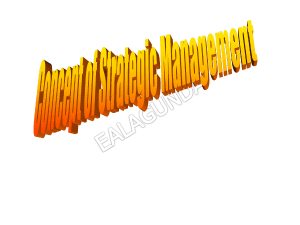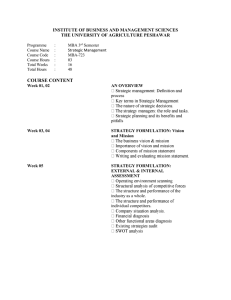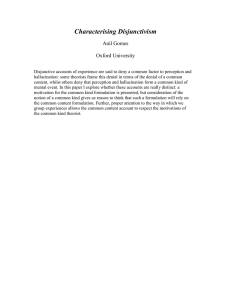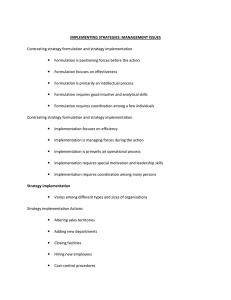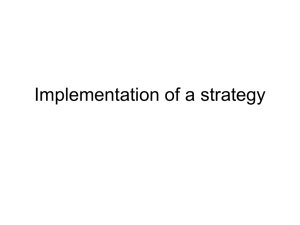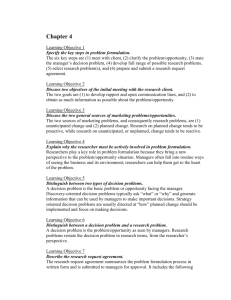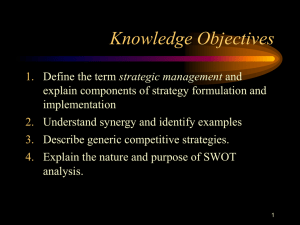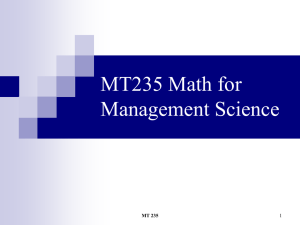Strategic Management Basics: Concepts & Process
advertisement
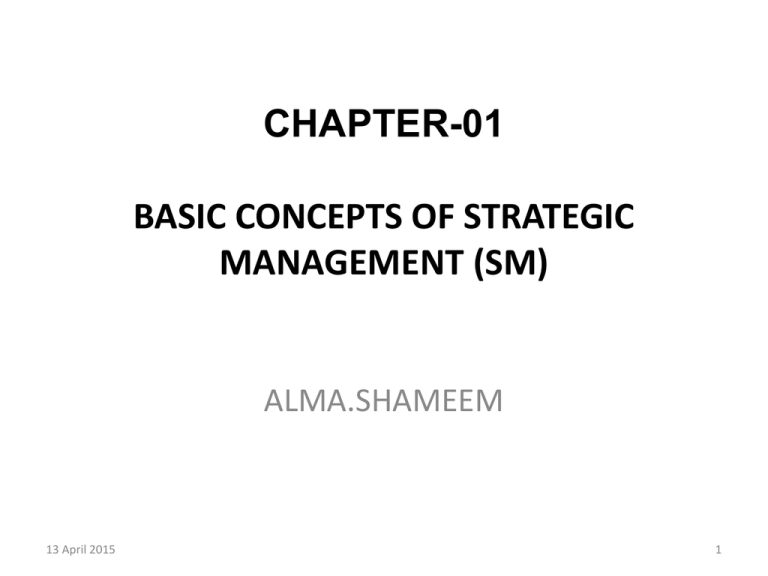
CHAPTER-01 BASIC CONCEPTS OF STRATEGIC MANAGEMENT (SM) ALMA.SHAMEEM 13 April 2015 1 Learning Objectives After studying this chapter, you should be able to do the following: • Define the term strategic management (SM) • Describe the SM process. • Explain the need for integrating analysis and intuition in strategic management. • Explain the benefits of strategic management. • Explain the impacts of Globalization and E-commerce on SM. • Describe the theory of learning organization. • Explain the basic model of SM. • Discuss the basic model of SM: The nature of strategy formulation, implementation, and evaluation activities. • Describe the strategic decision making model. • Discuss how a firm may achieve sustained competitive advantage. 13 April 2015 2 Strategic Management • SM is that set of managerial decisions and actions that determines the long run performance of a company. • How does a company become successful and stay successful? 13 April 2015 3 4 Phases in the Evolution of Strategic Management /4 Types of Strategic Management 1. 2. 3. 4. Basic financial planning – internal focus on budgeting (1 yr horizon) Forecast-based planning – extrapolate the current situation into the future (3-5 yr horizon) Externally-oriented planning – planning department and/or consultants develop a top-down strategy with no lower level involvement. Strategic management – involves various departments and levels across the organization. An ongoing process that includes implementation, evaluation and control issues. 13 April 2015 4 Benefits of SM Key Questions • Where is the organization now? • If no changes are made, where will the organization be in 1, 2, 5 or 10 years? • What specific actions should management undertake? • What are the risks and payoffs 13 April 2015 5 Benefits of SM Why need Strategic Management? • Clearer sense of strategic vision • Sharper focus on strategic importance • Improved understanding of changing environment 13 April 2015 6 Benefits of SM Following are the major benefits of Strategic management: • Proactive in shaping firm’s future • Initiate and influence actions • Formulate better strategies (Systematic, logical, rational approach) Financial benefits: • Improved productivity • Improved sales • Improved profitability Non-Financial benefits: • Increased employee productivity • Improved understanding of competitors’ strategies • Greater awareness of external threats • Understanding of performance reward relationships • Better problem-avoidance • Lesser resistance to change 7 Globalization & E-Commerce Challenges to SM • Impact of Globalization – Internationalization of markets & corporations – Markets: global than national markets • Impact of Electronic Commerce – Internet to conduct business transactions – Basis for competition on a more strategic level rather than traditional focus on product features and costs 13 April 2015 8 Theories of Organizational Adaptation Population Ecology (Can’t Change) vs. Institutional Theory (Mimic successful organizations) Strategic Choice Perspective (Management decisions have at least as much impact as industry factors) Organizational Learning Theory 13 April 2015 9 Creating Learning Organization (LO) • LO is skilled at creating, acquiring and transferring knowledge and modifying its behavior to reflect new knowledge and insight. • Key Activities: – – – – Solve problems systematically Experiment with new approaches Learn from experience Transfer knowledge throughout the organization 13 April 2015 10 Basic Model of SM • Four Basic Elements 13 April 2015 11 The term used in previous slide are explained here. 13 April 2015 12 1.Environmental Scanning • Monitoring, evaluation, and disseminating information from external and internal environments –to key people in the firm SWOT Analysis • Strengths – Weaknesses • Opportunities – Threats 13 April 2015 13 1. Environmental Scanning 13 April 2015 14 2. Strategy Formulation • Development of longrange plans for effective management of opportunities and threats in light of corporate strengths and weaknesses 13 April 2015 15 2.Strategy Formulation Vision statement • “Vision is the art of seeing things invisible” Jonathan Swif Mission Statement • • • • Purpose/reason for organization Promotes shared expectations Communicates public image Who we are; what we do; what we aspire to 13 April 2015 16 2.Strategy Formulation Corporate Goals/Objectives flow from the Mission/Vision statement • • • • Profitability (net profit) Growth Resource utilization (ROE, ROI) Market leadership Corporate Goals/Objectives need to be: • • • • • Specific Measurable Action oriented Realistic Timing is identified SMART Goals 13 April 2015 17 2. Strategy Formulation • Selecting Strategy / Hierarchy of Strategy – Corporate strategy (Stability, Growth, Retrenchment) – Business strategy (Competitive, Cooperative) – Functional strategy (Technological Leadership, Technological Followership) • Defining Policies – Guidelines for decision making that links formulation to implementation 13 April 2015 18 3. Strategy Implementation Process by which strategies and policies are put into action through development of programs and procedures Programs Strategy Implementation Budgets Procedures 13 April 2015 19 3. Strategy Implementation • Programs – single use plans (projects) • Budgets – costs associated with a program • Procedures – system of sequential steps that describe how a particular task or job is to be done 13 April 2015 20 4.Evaluation and Control • Process by which corporate activities and performance results are monitored so that actual performance can be compared with desired performance. Feedback/Learning Process • Must go back to revise or correct decisions made earlier. 13 April 2015 21 Triggering Events • • • • • New CEO External Intervention Threat of change in ownership Performance Gap Strategic inflection point (industry) 13 April 2015 22 Strategic Decisions – Rare – unusual, no precedent – Consequential – commit substantial resources – Directive – set precedents for decision making 13 April 2015 23 Mintzberg’s Modes of Strategic Decision Making • Entrepreneurial mode – founders vision • Adaptive mode – “muddling through” (reactive) • Planning mode – systematic gathering and analysis of information • Logical incrementalism – interactive strategy development (Planning + Adaptive) 13 April 2015 24 Strategic Decision Making Model 13 April 2015 25 Strategic Decision Making 13 April 2015 26 Elements of Good Strategy 1. Arenas – Where? 1. Vehicles – How to get there? 1. Differentiators – How to win? 1. Staging – Speed and sequence – tactics 1. Economic logic – How will we gain a return? 13 April 2015 27 Key Reference • Chapter 01-J David Hunger and Thomas L Wheelan, Strategic Management and Business Policy (10th Edition), Addison Wesley Lingman Inc. 13 April 2015 28 Thank You Chapter Roundup and Discussions 13 April 2015 29


